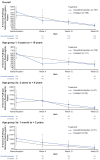Sacubitril/Valsartan in Pediatric Heart Failure (PANORAMA-HF): A Randomized, Multicenter, Double-Blind Trial
- PMID: 39319469
- PMCID: PMC11593999
- DOI: 10.1161/CIRCULATIONAHA.123.066605
Sacubitril/Valsartan in Pediatric Heart Failure (PANORAMA-HF): A Randomized, Multicenter, Double-Blind Trial
Abstract
Background: Sacubitril/valsartan, an angiotensin receptor-neprilysin inhibitor (ARNI), is an established treatment for heart failure (HF) with reduced left ventricular ejection fraction. It has not been rigorously compared with angiotensin-converting enzyme inhibitors in children. PANORAMA-HF (Prospective Trial to Assess the Angiotensin Receptor Blocker Neprilysin Inhibitor LCZ696 Versus Angiotensin-Converting Enzyme Inhibitor for the Medical Treatment of Pediatric HF) is a randomized, double-blind trial that evaluated the pharmacokinetics and pharmacodynamics (PK/PD), safety, and efficacy of sacubitril/valsartan versus enalapril in children 1 month to <18 years of age with HF attributable to systemic left ventricular systolic dysfunction (LVSD).
Methods: Children with HF attributable to LVSD were randomized to sacubitril/valsartan versus enalapril to assess the efficacy and safety of sacubitril/valsartan at 52 weeks of follow-up. The primary end point of the study was to determine whether sacubitril/valsartan was superior to enalapril for the treatment of pediatric patients with HF attributable to systemic LVSD, assessed using a primary global rank end point consisting of ranking patients from worst to best on the basis of clinical events such as death, listing for urgent heart transplant, mechanical life support requirement, worsening HF, New York Heart Association (NYHA)/Ross class, Patient Global Impression of Severity (PGIS), and Pediatric Quality of Life Inventory physical functioning domain. The change from baseline to 52 weeks in NT-proBNP (N-terminal pro-B-type natriuretic peptide) was an exploratory end point.
Results: A total of 375 children (mean age, 8.1±5.6 years; 52% female) were randomized to sacubitril/valsartan (N=187) or enalapril (N=188). At week 52, no significant difference was observed between the 2 treatment arms in the global rank end point (Mann-Whitney probability, 0.52 [95% CI, 0.47-0.58]; Mann-Whitney odds, 0.91 [95% CI, 0.72-1.14]; P=0.42). At week 52, clinically meaningful reductions were observed in both treatment arms in NYHA/Ross, PGIS, Patient Global Impression of Change, and NT-proBNP, without significant differences between groups. Adverse events were similar between treatment arms (incidence: sacubitril/valsartan, 88.8%; enalapril, 87.8%), and the safety profile of sacubitril/valsartan was acceptable in children.
Conclusions: In this study, sacubitril/valsartan did not show superiority over enalapril in the treatment of children with HF attributable to systemic LVSD using the prespecified global rank end point. However, both treatment arms showed clinically meaningful improvements over 52 weeks.
Registration: URL: https://www.clinicaltrials.gov; Unique identifier: NCT02678312.
Keywords: enalapril; heart failure; valsartan; ventricular dysfunction, left.
Conflict of interest statement
Dr Shaddy is a consultant for Novartis, American Regent Inc., CRI Biotech, and Rocket Pharmaceuticals. S. Solar-Yohay is an employee of US Novartis Pharmaceuticals Corporation and owns stocks in Novartis Pharma AG, Basel, Switzerland. Dr Garito is an employee of Novartis Pharma AG, Basel, Switzerland, and owns its shares. Dr Zhang is an employee of Novartis, Shanghai, China. M. Kocun is an employee of US Novartis Pharmaceuticals Corporation and owns stocks in Novartis Pharma AG, Basel, Switzerland. Dr Canter holds a Data and Safety Monitoring Board chairman position at the Mayo Research Foundation and has participated on an advisory board for CareDx. Dr Rossano reports receiving consulting fees from Bayer, Enzyvant, Merck, AskBio, American Regent, and Bristol Myers Squibb. Dr Halnon reports receiving consulting fees from Novartis and grants or contracts to her institution from Novartis. Dr Daly reports grants or contracts for the TEAMMATE multicenter trial of post–heart transplant immunosuppression (different patient population; Novartis holds the nonexclusive rights to one of the drugs that was studied [everolimus] but Novartis did not provide any support for the TEAMMATE study) and for American Heart Association/Enduring Hearts (ancillary studies to the TEAMMATE study in heart transplant recipients [different drug and patient population]); consulting fees from AstraZeneca (consultation regarding a different pediatric heart failure drug and possible study in children); payment or honoraria for lectures, presentations, speaker bureaus, manuscript writing, or educational events from CareDx (pediatric research board related to the use of Allosure Heart in transplant recipients); leadership or fiduciary role in other board, society, committee or advocacy group, paid or unpaid in ISHLT program committee 2021–2023 (developed ISHLT scientific sessions program) and AST trainee and young faculty community of practice chair (developed content for fellows and young faculty as part of the AST). Dr Singh is co-chair of the end point adjudication committee at Novartis for PANORAMA-HF. Dr Senni reports receiving consulting fees and payment or honoraria for lectures, presentations, speaker bureaus, manuscript writing, or educational events from Novartis, Bayer, Merck, MSD, Abbott, AstraZeneca, Boehringer, Vifor, and Novo Nordisk. Dr Anjos reports an unpaid position as a board member of the pediatric cardiology section of the Portuguese Medical Association. Dr Bonnet reports consulting fees from Novartis paid to his institution for being the steering committee member for the current study and participating in an advisory board for the current study. The other authors declare no competing interests.
Figures


References
-
- Shaw TB, Blitzer D, Carter KT, Lirette S, Mohammed A, Copeland J, Baran DA, Copeland H. Functional status of heart transplant recipients predicts survival. Clin Transplant. 2022;36:e14748. doi: 10.1111/ctr.14748 - PubMed
-
- Peng DM, Zhang Y, Rosenthal DN, Palmon M, Chen S, Kaufman BD, Maeda K, Hollander SA, McDonald N, Smoot LB, et al. . Impact of heart transplantation on the functional status of US children with end-stage heart failure. Circulation. 2017;135:939–950. doi: 10.1161/CIRCULATIONAHA.115.016520 - PubMed
-
- Masarone D, Valente F, Rubino M, Vastarella R, Gravino R, Rea A, Russo MG, Pacileo G, Limongelli G. Pediatric heart failure: a practical guide to diagnosis and management. Pediatr Neonatol. 2017;58:303–312. doi: 10.1016/j.pedneo.2017.01.001 - PubMed
-
- Kirk R, Dipchand AI, Rosenthal DN, Addonizio L, Burch M, Chrisant M, Dubin A, Everitt M, Gajarski R, Mertens L, et al. . The International Society for Heart and Lung Transplantation guidelines for the management of pediatric heart failure: executive summary [corrected]. J Heart Lung Transplant. 2014;33:888–909. doi: 10.1016/j.healun.2014.06.002 - PubMed
Publication types
MeSH terms
Substances
Associated data
LinkOut - more resources
Full Text Sources
Medical
Research Materials
Miscellaneous

